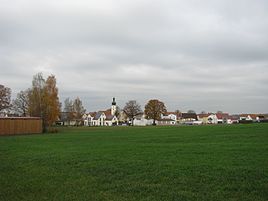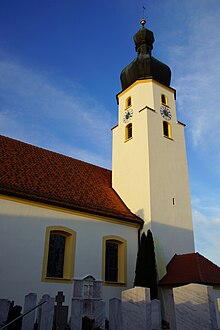Forchheim (Freystadt)
|
Forchheim (Freystadt)
City of Freystadt
Coordinates: 49 ° 9 ′ 38 ″ N , 11 ° 20 ′ 9 ″ E
|
|
|---|---|
| Residents : | 727 (December 31, 2016) |
| Incorporation : | July 1, 1972 |
| Postal code : | 92342 |
| Area code : | 09179 |
|
Forchheim
|
|
Forchheim in der Oberpfalz (Bavaria) is a church village and district of the city of Freystadt in the district of Neumarkt in the Upper Palatinate .
location
Forchheim is located between Nuremberg and Regensburg, about 5 km from the A 9 , Hilpoltstein exit , directly on the Main-Danube Canal .
history
A document from 1282 speaks of goods belonging to the Wolfstein house monastery in Forchheim, Seligenporten . On February 18, 1292, a Chunradus de Geyrsriut sold the Seligenporten monastery a farm in "Vorchaim", as noted in the Regesta Boica . You can also read there that in 1321 “Herman auf dem Pühel zu Vorcheim” has the “Burghof zu Vorcheim” from the Rebdorf monastery as a fief ; this in turn had received it from Ulrich von Soltzpurch (= Sulzbuerg ). In 1326 the canon Konrad von Sulzbürg brought, among other things, a court to Forchheim into the Rebdorf monastery. When in 1369 a contract sealed the separation of property among the Wolfsteiners, goods in Forchheim were assigned to the Wolfstein castle Obersulzbürg , namely two 1/16 yards, as a directory from 1740 shows. Most of the village, 27 courtyards and the parish shepherd's house, were under the Wolfstein rule of Pyrbaum . Until the Reformation , the Freystadt city judge was also responsible for Forchheim; So the Forchheimers had to bring their taxes to the weekly markets there. In 1540 the mayor's office in Neumarkt introduced the Reformation in Forchheim; from 1580 it was a Calvin parish. In 1625 the Counter Reformation brought the re-establishment of the Catholic faith and the “deportation” of the Lutheran school teacher. Forchheim became a branch of the parish Freystadt, but regained independence in 1670 and was reoccupied in 1702. During the Thirty Years War in 1632 half the village, including the parish and school house, burned away; the rectory was rebuilt in 1723 by the master mason JB Camesino from Obermässing . The school and sacristan's house was rebuilt by the community in 1766 and again in 1834 and 1890.
At the end of the Old Kingdom , around 1800, Forchheim consisted of 59 properties, which were subject to the high court of the Neumarkt mayor's office, to their respective manorials in the lower court, and there were nine in number: The largest manor was the electoral cabinet rule Pyrbaum (the Wolfsteiners died out in 1740 and you Ownership passed to the Bavarian Elector as a failed fiefdom ) with 27 properties. The Oberen Hofmark Berngau owned 13 properties, one of which was administered for the Neumarkt alms office. The electoral monastery judge Seligenporten had seven rear seats, the monastery judge Plankstetten three. The Berching Probstamt , the Imperial City of Nuremberg (Altdorf Nursing Office ) and the electoral cabinet rule Sulzbürg each owned two subject properties. One property each belonged to the Hilpoltstein nursing office and the prince-bishop-Eichstatt caste office Jettenhofen . The shepherd's house belonged to the community.
In the new Kingdom of Bavaria (1806), Forchheim became a tax district in the Neumarkt Regional Court and Rent Office, to which Sulzkirchen still belonged. Without Sulzkirchen, the rural community Forchheim was formed in 1811 , which was left as it was with the community edict of 1818. In 1827 it was separated from this regional court and assigned to the Beilngries regional court . This came in 1838 from the Regenkreis to the previous Rezatkreis , which was renamed Middle Franconia . In 1875 the place consisted of 159 buildings, 76 of which were residential buildings. The rural village character is also evident from the livestock: in 1875 there were 30 horses, 385 head of cattle, 475 sheep, 153 pigs and four goats. 25 years later there were officially 17 horses, 457 head of cattle, 171 sheep, 340 pigs and six goats. The sharp increase in pig farming with a simultaneous decline in sheep farming can also be observed in many other Bavarian communities during this period.
After the Second World War , Forchheim had about 418 inhabitants, who were mostly farmers. Others worked as craftsmen and traders.
There is a warehouse about 500 m from the town center. The barracks were built by the Rhein-Main-Donau AG before the Second World War to accommodate the workers for the canal construction in this area. During the war it served as a military training camp . After the war it became a prison camp and later a retirement home that existed until 1953. The first refugees from the Eastern Zone arrived on December 24, 1953. It served as a refugee transit camp until 1956.
When the district of Beilngries was dissolved in the course of the regional reform in Bavaria , Forchheim became part of the district of Neumarkt. On July 1, 1972, the previously independent community was incorporated into Freystadt.
Population numbers
- 1830: 340 (68 properties)
- 1867: 392 (69 buildings, 1 church, school)
- 1875: 386 (383 Catholics, three Protestants)
- 1900: 372 (78 residential buildings)
- 1937: 398 (Catholics only)
- 1950: 596 (82 properties)
- 1987: 509 (127 residential buildings, 157 apartments)
- December 31, 2016: 727
Parish Church of St. Giles
In 1448 the church is supposed to be dedicated to St. Maternus as patron, in 1480 today's patron, St. Aegidius mentioned. The church is a new building from 1721/24; it was consecrated on June 24th, 1724, after an enlargement again on May 31st, 1767. In 1904 an extension took place, so that the ship has the dimensions 24 × 10 m since then. In 1907 an organ from Edenhofer came into the church in Deggendorf . The Lourdes Grotto in the Chapel of the Dead dates from 1892. In the tower with its dome hung three bells in 1937, from 1450, 1750 and 1874.
societies
- Fruit and horticultural association
- Forchheim / Obermässing fishing association
- Soldiers 'and warriors' association
- Volunteer firefighter
- FC Forchheim
See also
- Franz Pröbster Kunzel ( Land Art artist)
literature
- Franz Xaver Buchner : The diocese of Eichstätt. Volume I, Eichstätt: Brönner & Däntler, 1937
- Bernhard Heinloth: Historical Atlas of Bavaria. Part Altbayern, Issue 16: Neumarkt , Munich: Commission for Bavarian State History, 1967
- Gerhard Hirschmann: Historical Atlas of Bavaria. Part of Franconia. Row I, Issue 6. Eichstätt. Beilngries - Eichstätt - Greding, Munich 1959
Web links
Individual evidence
- ↑ Heinloth, p. 138
- ^ Carl Heinrich Lang: Regesta sive Rerum Boicarum Autographa , Part 4, Munich 1828, p. 508
- ^ Carl Heinrich Lang: Regesta sive Rerum Boicarum Autographa , Part 6, Munich 1828, Munich 1837, p. 31
- ↑ Buchner II, p. 602
- ↑ Heinloth, pp. 98, 107 f.
- ↑ Heinloth, p. 227
- ↑ Buchner I, p. 334
- ↑ Buchner I, p. 334
- ↑ Buchner I, p. 334 f.
- ↑ Heinloth, p. 260
- ↑ Hirschmann. Pp. 176, 181, 213
- ↑ Kgl. Statistical Bureau in Munich (edit.): Complete list of localities of the Kingdom of Bavaria ... based on the results of the census of December 1st. 1875 , Munich 1876, column 1157
- ↑ Kgl. Statistical Bureau in Munich (edit.): Localities directory of the Kingdom of Bavaria ... [based on the results of the census of December 1, 1900] , Munich 1904, column 808
- ^ Wilhelm Volkert (ed.): Handbook of Bavarian offices, communities and courts 1799–1980 . CH Beck, Munich 1983, ISBN 3-406-09669-7 , p. 533 .
- ↑ Hirschmann, p. 213
- ↑ Joseph Heyberger: Topographical-statistical manual of the Kingdom of Bavaria with an alphabetical local dictionary , Munich 1867, Sp. 992
- ↑ Kgl. Statistical Bureau in Munich (edit.): Complete list of localities of the Kingdom of Bavaria ... based on the results of the census of December 1st. 1875 , Munich 1876, column 1157
- ↑ Kgl. Statistical Bureau in Munich (edit.): Localities directory of the Kingdom of Bavaria ... [based on the results of the census of December 1, 1900] , Munich 1904, column 808
- ↑ Buchner I, p. 336
- ↑ Hirschmann, p. 213
- ^ Official register of places for Bavaria, territorial status: May 25, 1987 , Munich 1991, p. 258
- ^ Website of the city of Freystadt
- ↑ Buchner I, pp. 74, 334-336
- ↑ Buchner I, p. 335
- ↑ Buchner I, p. 336
- ↑ Farmer Kunzel's Landart: The "Garden of Sacred Insanity"


